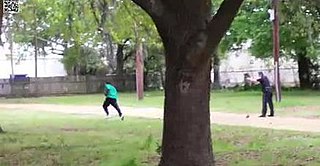Suicide by cop, also known as suicide by police or law-enforcement-assisted suicide, is a suicide method in which a suicidal individual deliberately behaves in a threatening manner, with intent to provoke a lethal response from a public safety or law enforcement officer to end their own life.
Henry Bruce Stanley was a Scottish painter and decorator who was shot dead by the Metropolitan Police in London in contentious circumstances. Initially his death was recorded with an open verdict, before being ruled as unlawful killing by a jury on appeal and finally returned to an open verdict by the High Court.

The Queen Street massacre was a mass shooting which occurred on 8 December 1987 at Australia Post offices on 191 Queen Street in Melbourne, Victoria.

The Service de police de la Ville de Montréal is the municipal police agency for the city of Montreal, Quebec, Canada, and the neighbouring communities in the urban agglomeration of Montreal. With over 4,500 officers and more than 1,300 civilian staff, it is the second-largest municipal police agency in Canada after the Toronto Police Service.
Ian Bush, was a Canadian who was killed while in police custody. Significant ongoing controversy has been generated by the case. Ian Bush was a young man living in Houston, B.C. who was shot in the back of the head and killed by Royal Canadian Mounted Police Constable Paul Koester, after being arrested outside a hockey game. Many members of the community believe there were several flaws in the investigation, that there may have been a cover-up and conspiracy to protect Cst Koester. A full inquiry was held by the Commission for Public Complaints against the RCMP.

Taser safety issues relate to the lethality of the Taser. The TASER device is a less-lethal, not non-lethal, weapon, since the possibility of serious injury or death exists whenever the weapon is deployed. It is a brand of conducted electroshock weapon sold by Axon, formerly TASER International. Axon has identified increased risk in repeated, extended, or continuous exposure to the weapon; the Police Executive Research Forum says that total exposure should not exceed 15 seconds.

On October 14, 2007, Robert Dziekański, a 40-year old Polish immigrant to Canada, was killed during an arrest at the Vancouver International Airport in Richmond, British Columbia (BC).

Mark Duggan, a 29-year-old black British man, was shot dead by police in Tottenham, North London on 4 August 2011. The Metropolitan Police stated that officers were attempting to arrest Duggan on suspicion of planning an attack and that he was in possession of a handgun. Duggan died from a gunshot wound to the chest. The circumstances of Duggan's death resulted in public protests in Tottenham, which led to conflict with police and escalated into riots across London and other English cities.
Adam Salter was shot and killed in his Sydney home in November 2009 after police responded to a call that the 36-year-old was stabbing himself with a knife. He was shot in the back by a New South Wales Police Sergeant Sheree Bissett who yelled "Taser, Taser, Taser" before discharging her gun. The shooter later claimed that Salter was threatening another officer with the knife and that lethal force was her only option. However, the coroner found that there was strong evidence that the policewoman mistakenly used her gun instead of her taser.
Michael Capel, 43, a man with schizophrenia, died on 10 October 2008, from multiple gunshot wounds during a confrontation with police at Belmont, near Newcastle, New South Wales. The shooting followed reports that Capel had assaulted his mother and a local worker. Apparently Capel had come off his medication and become violent. A coronial inquest into Capel's death heard that he had "opened the door to police while holding a large knife and began walking towards officers". Following the death, a coroner has recommended special training for frontline police dealing with the mentally ill.
Roberto Laudisio Curti, known as Beto Laudisio, was a 21-year-old man from São Paulo, Brazil. He died on 18 March 2012 after being pursued, tackled, tasered, sprayed with OC spray, and physically compressed under the weight of multiple police officers of the New South Wales Police Force in Sydney, Australia.

The use of firearms by police forces varies widely across the world, in part due to differences in gun use policy, civilian firearm laws, and recording of police activity. Police forces may require that officers use warning shots before aiming on-target, officers may need to make verbal warnings before using their firearms, and officers may be prohibited from carrying weapons while performing tasks such as highway patrol where gun use is not expected.

On April 4, 2015, Walter Scott, a 50-year-old black man, was fatally shot by Michael Slager, a local police officer in North Charleston, South Carolina, United States. Slager had stopped Scott for a non-functioning brake light. Slager was charged with murder after a video surfaced showing him shooting Scott from behind while Scott was fleeing, which contradicted Slager's report of the incident. The radical difference led many to believe that the shooting was racially motivated, generating a widespread controversy.

Jordan Lee Begley, also known as Jordon Begley, a 23-year-old English man, died of cardiac arrest on 10 July 2013. An inquest in 2015 found that Begley's death had been partly due to the actions of Greater Manchester Police officers who shot him with a Taser while they restrained and handcuffed him around two hours prior to his death.
Edson Da Costa was a 25-year-old Black Portuguese man who died on 21 June 2017 after being stopped by police on 15 June in Beckton, London. The unclear circumstances of his death led to protests. In June 2019, an inquest jury found that Da Costa died by misadventure from the consequences of a cardiorespiratory arrest after he placed in his mouth a plastic bag containing 88 wraps of class A drugs. The coroner ruled that there was no "legal or factual basis" for a conclusion that could be critical of the police. An investigation by the Independent Office for Police Conduct concluded that the restraint by officers was necessary and proportionate.
On June 4, 2020, Chantel Moore, an Indigenous Canadian woman, was shot and killed by Constable Jeremy Son of the Edmundston, New Brunswick police, who were called to perform a wellness check on her. Moore's death drew national attention and outrage. However, New Brunswick’s public prosecution service said it found Son's actions to be reasonable in the circumstances and he was not charged with any crime.
On 30 December 2020, the Garda Armed Support Unit shot 27-year-old George Nkencho in Clonee on the Dublin–Meath border, after graduated attempts to detain him failed. He had allegedly assaulted a shop staff member and threatened others with a knife. Nkencho had been suffering from mental health issues in the preceding months and according to Gardaí, he did not have any criminal convictions.
Police brutality is an instance or pattern of excessive and unwarranted force used against an individual or group of people. The Indigenous peoples of Canada include, as designated by the Canadian government, Inuit, Metis, and First Nations individuals and are officially considered Aboriginal peoples. Indigenous Canadians have experienced strenuous relationships with police as a result of colonization and lasting tensions. Since the early 2000s, several instances of police brutality against Indigenous Canadians have prompted media attention.







